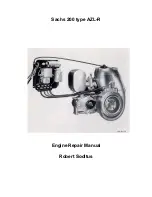
46
ENGINE STARTED
To insure adequate lubrication, operate engine at or
below 1200 rpm with no load for 1-2 minutes. Extend
this period to 2–4 minutes at freezing or sub-zero
temperatures.
1. Check oil pressure gauge as soon as engine starts.
If gauge needle does not level up to minimum oil
pressure specification within 5 seconds, stop the
engine and determine the cause.
2. Watch coolant temperature gauge. Do not place
engine under full load until properly warmed up.
It is a good practice to operate the engine under a lighter
load and at lower speeds than normal for the first few
minutes after start-up.
STARTING WITH BOOSTER BATTERIES
CAUTION !
Make sure to use batteries with the same rated voltage
as the engine’s system voltage. On an engine with a
two pole electrical system, connect the other end of
the jumper cable to the negative pole (-) of the booster
battery.
1.
Connect the jumper cable to the positive pole (+) of
the flat battery, then to the positive pole (+) of the
booster battery.
2.
Connect the jumper cable to the negative pole (-) of
the booster battery. Connect the other end to a bolt
of the engine block.
Start the engine following the starting procedure.
3. Let the engine run at idle for few minutes to charge
the battery.
4. Stop the engine and remove the cables in the exact
reverse order from installation.
ENGINE RELUCTANT TO START
If a water lift (water lock) muffler is installed on the
exhaust line, excessive cranking could cause seawater
to enter the cylinders and damage the engine. To start
engine, reduce starting attempts to three and if not OK,
undertake to do this :
1.
Close the seacock to avoid filling the muffler with
water.
2. Try to start the engine by following the regular
starting procedure.
3. When the engine does start, stop the engine
immediately and turn off the switch.
4. Re-open the seacock and restart the engine.
IDLING ENGINE
Avoid excessive engine idling as it may cause the coolant
temperature to fall below its normal range. This, in turn,
causes crankcase oil dilution, due to incomplete fuel
combustion, and permits formation of gummy deposits
on valves, pistons, and piston rings. It also promotes
rapid accumulation of engine sludge and unburned fuel
in the exhaust system.
Once an engine is warmed to normal operating
temperatures, engine should be idled at slow idle speed.
Slow idle speed for engine is set at the factory. If an
engine is left idling for more than 5 minutes, stop and
restart later.
Above : typical temperature and pressure Type 5 and 4 gauges.
Depending of engine type, oil pressure gauge may be of 5 or
10 bar dial.
S07
STARTING & RUNNING
Содержание N5.160 CR2
Страница 1: ...NANNI MARINE ENGINE OPERATOR MANUAL DGBXXT090013 ENGINE N5 160 CR2 N5 180 CR2 N5 200 CR2 N5 230 CR2...
Страница 2: ......
Страница 4: ......
Страница 37: ...37 S06 COMPONENTS SUMMARY SUMMARY 37 S06 COMPONENTS 38 ENGINE MAIN COMPONENTS 38 ENGINE VIEWS N5 CR2 39...
Страница 40: ...40 NOTES...
Страница 77: ...77 S08 MAINTENANCE INSTRUMENTS PANEL...
Страница 103: ......















































